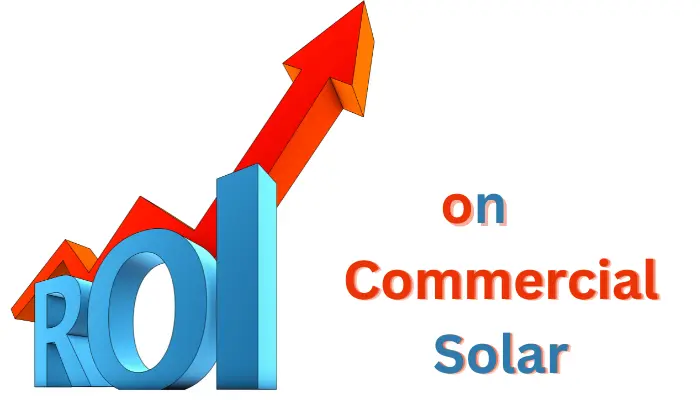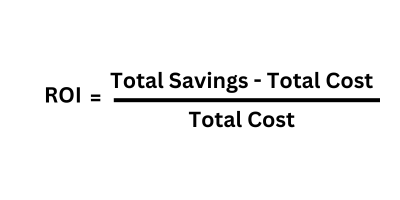What Is The ROI On Commercial Solar Panels?
Are high energy bills a problem for your California business? Commercial solar panel systems might be the solution. In this article, we will explore the return on investment (ROI) for these systems. We’ll look at the costs and benefits and explain how you can calculate the ROI for your business.
We will discuss businesses that have solar panels with batteries and share the benefits they have seen.
What Is The ROI & Payback on Commercial Solar Panels?

Commercial solar panels’ Return on Investment (ROI) and payback period show the financial benefits of installing them. ROI shows how profitable a solar system is by comparing its cost to the financial benefits over time. The financial benefits include energy bill savings. We conduct a comparison between the initial cost of the system and the total benefits received.
For example, if you spend $100,000 on a solar system and save $150,000 on energy bills over ten years, the ROI is 50%. On the other hand, the payback period is the time it takes for the savings from the solar system to equal the initial investment cost.
To find the payback period, divide the initial cost by the annual savings on energy bills. If the system costs $100,000 and saves $10,000 annually, the payback period is 10 years.
Understanding these metrics helps businesses determine if investing in solar panels is financially beneficial. Generally, a shorter payback period and higher ROI indicate a better investment.
How to Calculate ROI for Commercial Solar Panels
Calculating the return on investment (ROI) for commercial solar panel systems involves understanding solar economics. Here’s how to break it down:
Find the total cost of a commercial solar panel system with battery storage to calculate its ROI. This cost should include the solar panels, battery storage, and installation.
Next, calculate the total savings from the system over time. This includes savings from lower electricity costs and the higher property value. The formula is:

Components of Total Savings:
Avoided Electricity Costs: The amount saved by generating your own electricity instead of buying it from the grid.
Increased Property Value: The boost in property value due to the installation of the solar system.
Components of Total Cost:
Solar Panels: The price of the solar panels themselves.
Battery Storage System: The cost of the batteries used to store excess solar energy.
Installation Costs: Expenses related to installing the commercial solar and battery systems.
Several factors affect the ROI of a solar panel system with commercial solar battery storage:
System Size: Larger systems generate more electricity and lead to higher savings.
System Cost: Costs can vary based on the size, type of panels, battery storage, and installation expenses.
Local Electricity Rates: Higher local electricity rates result in greater savings.
Tax creditsIncentives and Rebates: These can significantly lower the initial cost and enhance ROI.
Example Calculation:
Suppose you install a 15 kW solar panel system with battery storage costing $150,000. This system offsets your annual electricity usage, saving you $18,000 per year. The battery storage allows you to store excess solar energy for use at night, reducing your electricity costs further. Additionally, the system increases your property value by $20,000.
Over 20 years, you save $360,000 on electricity and gain $20,000 in property value, totaling $380,000 in savings. The ROI calculation would be:
\text{ROI} = \frac{($380,000 – $150,000)}{$150,000} = 1.53
This means the system will pay for itself in just under six years, yielding an ROI of 1.53.
Solar panel systems with commercial battery storage can be a good investment. The return on investment (ROI) may vary depending on different factors. Before making a decision, make sure to thoroughly research and consider all costs and benefits of the investment.
Comparing Solar Energy ROI to Stock Market Returns
The average ROI for all commercial solar projects is 16.2%. Let’s compare the value of this ROI to investing in stocks.
Investing in stocks typically yields a 10% return in the long run. In most states, solar energy investments for farms and businesses yield a higher return than the average stock investment. Moreover, the risks associated with solar energy investments are much lower compared to the stock market.
Solar energy provides a reliable source of electricity because it relies on the almost guaranteed sunshine. Your stock market profits depend on the company you pick and the economy as a whole. Unpredictable consumer behaviors can affect the economy. This makes solar energy a more stable and reliable investment.
Commercial Solar Benefits
Commercial solar panel systems offer several benefits for businesses:
Reduced Business Energy Costs:
Installing solar panels can save money by storing solar energy for use at night. This is especially helpful during peak times when electricity rates are high.
Increased Energy Independence:
Businesses gain energy independence with solar panels, providing a reliable backup during power outages, crucial for continuous operations.
Improved Grid Resilience:
Solar systems support the grid by offering backup power during peak demand or outages. This support prevents disruptions for businesses and customers.
Enhanced Commercial Sustainability:
Battery storage systems help businesses reduce their environmental footprint by storing solar energy and supporting sustainability goals.
In addition to these benefits, commercial solar power systems contribute to:
- Improved Asset Protection
- Increased Productivity
- Enhanced Customer Satisfaction
Considering these advantages, evaluating the costs and benefits of commercial solar energy systems can help determine if they are a suitable investment for your business.
Factors Affecting Solar Panel ROI With Commercial Battery Storage
Several factors influence the return on investment (ROI) of a commercial solar panel system with battery storage:
Cost of the System:
The overall expense of a business solar panel system with battery storage fluctuates depending on the system’s size, the selected panel and battery types, and the costs of installation. Adding battery storage may be more expensive at first. However, it can increase the (ROI) return on investment. This is because stored energy can be used during peak demand or power outages.
Solar Energy Generation:
The amount of solar energy your system can generate depends on its size, panel orientation, and local sunlight conditions. Higher solar energy production generally leads to a higher ROI, though larger systems come with increased initial costs.
Electricity Rates:
Local electricity rates significantly impact ROI. Places with expensive electricity can save money with solar panels and batteries. Businesses can use stored solar power during peak hours to lower energy costs.
Tax Incentives and Rebates:
Available tax incentives and rebates can substantially reduce the upfront cost of a solar panel system, boosting ROI. Businesses should explore these financial incentives to maximize savings.
System Lifespan:
The lifespan of solar panels (about 25 years) and batteries (around 10 years) also affects ROI. Longer-lasting systems provide extended benefits over their lifespan, contributing positively to ROI calculations.
Examples:
A business in sunny California can save money by using solar energy instead of expensive grid electricity. This can be done by installing solar panels and batteries. Solar panels capture sunlight and convert it into electricity. Batteries store the electricity for use when needed. By using solar energy, the business can reduce its reliance on costly grid electricity.
A company in a location with cloudy weather and lower electricity costs may not profit as much from solar power. This is because there is less sunlight to generate energy. Businesses that meet the requirements for tax breaks and discounts can save money by lowering initial expenses. This makes solar panels with battery storage more cost-effective and lucrative for them.
Businesses that have long-term leases can save money by using solar and battery systems for an extended period. This allows them to maximize their energy savings.
Knowing these factors helps businesses determine if it’s financially smart to invest in solar panels with battery storage.
Maximizing Solar Panel ROI with Commercial Battery Storage
To maximize your commercial solar panel system ROI, follow these tips:
- Choose the Right System: Select a solar panel and battery storage system that meets your business’s energy needs. Consider factors like system size, efficiency, and compatibility with your energy usage patterns.
- Ensure Proper Installation: Proper installation is crucial for optimal system performance. Hire qualified professionals to install the solar panels and battery storage system according to manufacturer guidelines and local regulations.
- Utilize Tax Incentives and Rebates: Take advantage of available tax incentives and rebates for solar energy systems. These financial benefits can significantly reduce upfront costs and improve your ROI over time.
- Monitor System Performance: Regularly monitor your solar panel system’s performance to ensure it operates efficiently. Address any issues promptly to maintain maximum energy production and savings.
Follow these steps to improve your commercial solar panel system with battery storage. This will increase your return on investment and benefit your business in the long run.
Start using solar power in Santa Barbara.
Want to turn your roof into a source of clean energy? We’re here to help! At Solar Earth Inc., we assist homeowners and businesses in Santa Barbara and surrounding areas with using solar energy. We guide you through the entire process, from consultation to installation and ongoing support. Our goal is to make switching to solar energy easy for you.
